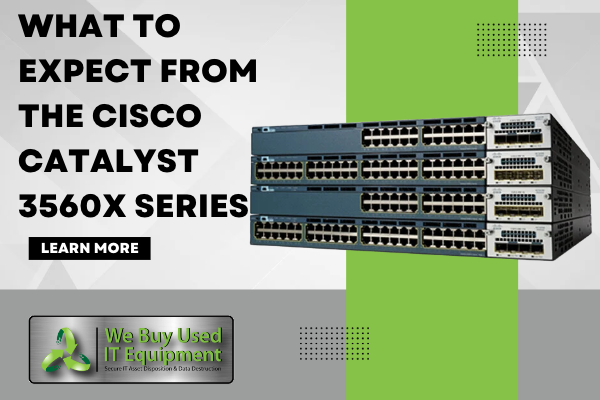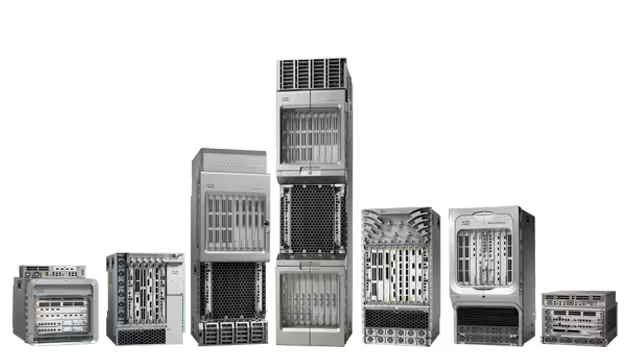Cisco ASR 9000 Series Reviewed
Networking switches refer to hardware devices that allow multiple devices to connect and communicate with each other within a computer network. They act as intermediaries between different devices, allowing them to share data packets efficiently.
Switches use the MAC address of individual devices to route data traffic through the network, which makes it possible for large amounts of information to be transferred quickly and securely. Switches are an essential piece of equipment in both small and large-scale networks since they allow users to access resources such as printers, servers, and Internet connections.
There are several types of switches available on the market today. The most common ones include unmanaged switches used for small home or office networks; managed switches utilized by IT professionals who need greater control over their networks; and PoE (Power over Ethernet) switches that can supply power directly to connected devices like IP cameras or VoIP phones.
Networking switches play a critical role in how modern organizations operate by enabling efficient communication among various connected devices.

Do you need a networking switch?
If you’re wondering whether or not you need a networking switch, the answer depends on your specific needs. A networking switch is a device that connects devices within a network and allows them to communicate with each other.
One key factor in determining if you need a networking switch is the size of your network. If you have only a few devices that need to be connected, such as two or three computers, then you may not require one. However, if your network has multiple devices such as printers, servers and computers then having a networking switch can help simplify connectivity.
Another consideration when thinking about needing a networking switch is the type of activities taking place on your network. For example, businesses often require switches because they frequently transfer large amounts of data between devices.
If security and efficiency are important aspects for your business or personal use then investing in a reliable Cisco ASR 9000 Series can provide better performance than standard consumer-grade switches. It’s important to evaluate your specific needs before deciding whether or not to invest in a networking switch like the Cisco ASR 9000 Series.

Cisco ASR 9000 Series: An overview
The Cisco ASR 9000 Series Aggregation Services Routers (ASR 9000 Series) represent an exciting new paradigm in edge and core routing, with exceptional scalability, carrier-class reliability, environmentally conscious design, incredible flexibility, and an attractive price-to-performance benchmark. The Cisco ASR 9000 Series has a wide product portfolio (Figure 1), ranging from the Cisco ASR 9001 (2 Rack Units [2RU]) to the Cisco ASR 9922 (44RU), with each system designed to provide true carrier-class reliability using the Cisco IOS XR operating system, comprehensive system redundancy, and a full complement of network resiliency schemes. Finally, the Cisco ASR 9000 Series is designed to simplify and enhance the operational and deployment aspects of service-delivery networks.
The Cisco ASR 9000 Series is an operationally simple, future-optimized platform using next-generation hardware and software. The following are highlights of this next-generation platform:
● Fully distributed system: The Cisco ASR 9000 Series operates in a fully distributed fashion; all packet-forwarding decisions and actions take place on the individual line cards. These high-density Ethernet line cards are equipped with a specialized network processor that provides a flexible programming infrastructure with high-density Hierarchical Quality-of-Service (H-QoS) services, security, and advanced timing capabilities, with PTP and Synchronous Ethernet (SyncE) support. The distributed nature of the Cisco ASR 9000 Series improves resiliency by adding a new dimension in scale for features such as Bidirectional Forwarding Detection (BFD) and Ethernet Operations, Administration, and Maintenance (EOAM).
● Operationally efficient and redundant hardware: The Cisco ASR 9000 Series provides an infrastructure where all common components, Route Switch Processors (RSPs), Route Processors (RPs), switching fabric, fans and power supplies are redundant. In addition, the platform is designed to use power on an as-needed basis, depending on system requirements. Power has been modularized for a true pay-as-you-grow approach, reducing Capital Expenditures (CapEx) and providing an operationally efficient deployment. Cisco ASR 9000 Series also provides advanced power management to control power utilization. The Cisco ASR 9000 Series also provides space-optimized, high capacity compact-platform options.
● Environmentally conscious design: In today’s world of increasing awareness of human impact on the environment and the resultant fiscal implications, Cisco ASR 9000 Series Routers bring a fresh new “conscious” approach to product development. From optimal thermal design to the architecture of the power infrastructure, from the placement of line-card components to the pitch of each slot, every design aspect has one goal in mind: reduced environmental impact through lowered power consumption and decreased cooling requirements. Even the product packaging process was evaluated to minimize the use of packaging material and thereby reduce waste at customer locations. The Cisco ASR 9000 Series is an example of the continued Cisco commitment to efficient and future-friendly product design.
● Cisco IOS XR Software modular operating system: The Cisco ASR 9000 Series uses the Cisco IOS XR operating system, which provides high-quality, ultra-scale and rich features. The Cisco IOS XR operating system uses a microkernel architecture to achieve true modularity. This modularity provides the path to nonstop operations during software image upgrades or module changes, without affecting normal platform functionality.
● Optimized for IPv6: Cisco is delivering on our strategy of building out IPv6 next-generation networks to simplify design, deployment, and management of services for global service providers.

Cisco ASR 9000 Series: Features and Benefits
The Cisco ASR 9000 Series Aggregation Services Routers provide unsurpassed speeds, up to 400 Gigabit Ethernet, with scale and high density. The Cisco ASR 9000 and ASR 9900 Series Routers provide flexible options for high-density 1 Gigabit Ethernet, 10 Gigabit Ethernet, 25 Gigabit Ethernet, 40 Gigabit Ethernet, 100 Gigabit Ethernet and 400 Gigabit Ethernet ports without the need for a complete chassis replacement.
These line cards, offered in base and extended-scale configurations, are complemented by the nonblocking fabric (on the RSP for the Cisco ASR 9006, ASR 9010, ASR 9906, ASR 9910 and ASR 9904 Routers and on separate fabric cards for the Cisco ASR 9906, ASR 9910, ASR 9912 and ASR 9922 Routers), and by the innovative backplane, thermal, and power infrastructure on the chassis.
The Cisco ASR 9000 Series has a modular power architecture available in both AC and DC. The power supplies are housed in field-serviceable Power Entry Modules (PEMs), which also come in AC and DC forms. Each PEM can hold up to three or four modules depending on its corresponding type, with no power zones or placement restrictions (mixing of AC and DC supplies is not supported).
Service providers can add more power as their bandwidth and feature requirements increase over time, by adding more line cards to the chassis. This capability translates to lower CapEx initially and optimal OpEx over the product life.
The Cisco ASR 9000 Series also features a fully integrated timing infrastructure, allowing the routers to take in timing inputs (for example, SyncE, GPS, Building Integrated Timing Supply [BITS], and DOCSIS® Timing Interface [DTI]) and distribute them over the backplane to each slot. This capability allows extensive support for transparent mobile convergence, mobile Radio Access Network (RAN) backhaul, and Time-Division Multiplexing (TDM) circuit emulation, without sacrificing performance or scale.
The optimized thermal infrastructure of the Cisco ASR 9000 Series is designed to be scalable to support future capacity requirements. Variable-speed high-efficiency fans provide reduced power requirements under normal operating environments while retaining the capability to cool current and future line cards under extreme conditions.
Conclusion
To sum it up, the Cisco ASR 9000 Series is a top-of-the-line networking switch that can handle even the most demanding network environments. Its high-capacity routing and switching capabilities make it an ideal choice for data centres, service providers, and enterprise networks.
While some organizations may not need such advanced features, those with large volumes of traffic or complex network architectures will benefit greatly from this powerful switch. With its modular design and ability to support multiple applications simultaneously, the ASR 9000 Series offers unparalleled performance and flexibility.
If you are looking for a reliable, high-performance networking solution that can meet your organization’s demands both now and in the future, look no further than the Cisco ASR 9000 Series.







